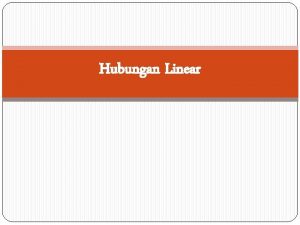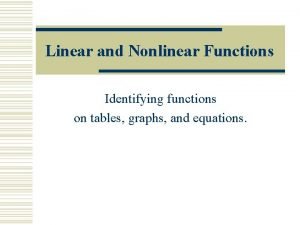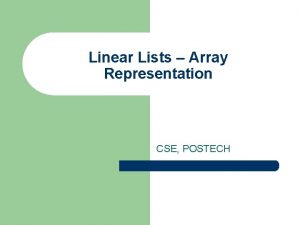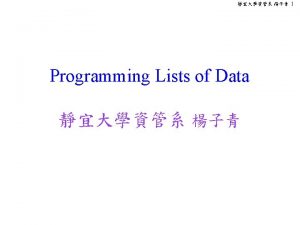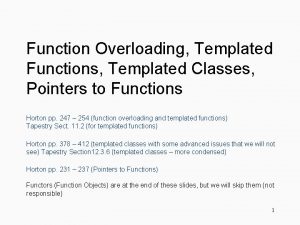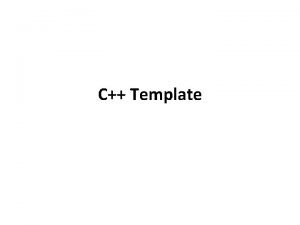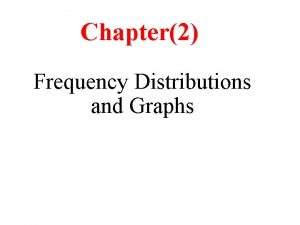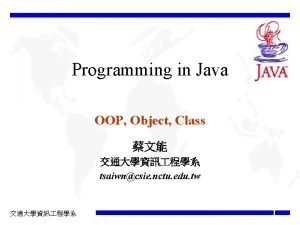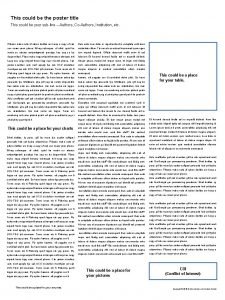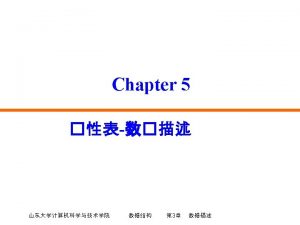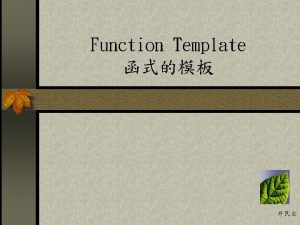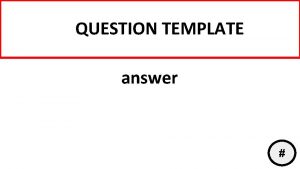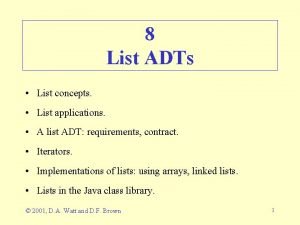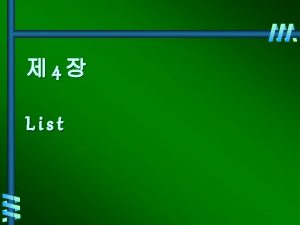template class T class E class Linear List







![顺序表的静态存储和动态存储 #define max. Size 100 typedef int T; typedef struct { T data[max. Size]; 顺序表的静态存储和动态存储 #define max. Size 100 typedef int T; typedef struct { T data[max. Size];](https://slidetodoc.com/presentation_image_h2/1f42dfa4aabbd1ff62a81cd2c0d8e6d3/image-8.jpg)






















































![多项式的顺序存储表示 第一种: private: (静态数 int degree; 组表示) float coef [max. Degree+1]; Pn(x)可以表示为: pl. degree 多项式的顺序存储表示 第一种: private: (静态数 int degree; 组表示) float coef [max. Degree+1]; Pn(x)可以表示为: pl. degree](https://slidetodoc.com/presentation_image_h2/1f42dfa4aabbd1ff62a81cd2c0d8e6d3/image-63.jpg)


![初始化: // term Polynomial: : term. Array[Max. Terms]; // int Polynomial: : free = 初始化: // term Polynomial: : term. Array[Max. Terms]; // int Polynomial: : free =](https://slidetodoc.com/presentation_image_h2/1f42dfa4aabbd1ff62a81cd2c0d8e6d3/image-66.jpg)

















































- Slides: 115





线性表的抽象基类 template <class T, class E> class Linear. List { public: Linear. List(); //构造函数 ~Linear. List(); //析构函数 virtual int Size() const = 0; //求表最大体积 virtual int Length() const = 0; //求表长度 virtual int Search(T x) const = 0; //搜索 virtual int Locate(int i) const = 0; //定位 virtual E* get. Data(int i) const = 0; //取值 virtual void set. Data(int i, E x) = 0; //赋值 5

virtual bool Insert(int i, E x) = 0; virtual bool Remove(int i, E& x) = 0; virtual bool Is. Empty() const = 0; virtual bool Is. Full() const = 0; virtual void Sort() = 0; virtual void input() = 0; virtual void output() = 0; virtual Linear. List<T, E>operator= (Linear. List<T, E>& L) = 0; //插入 //删除 //判表空 //判表满 //排序 //输入 //输出 //复制 }; § 线性表的存储表示有两种:顺序存储方式和 链表存储方式。 6

![顺序表的静态存储和动态存储 define max Size 100 typedef int T typedef struct T datamax Size 顺序表的静态存储和动态存储 #define max. Size 100 typedef int T; typedef struct { T data[max. Size];](https://slidetodoc.com/presentation_image_h2/1f42dfa4aabbd1ff62a81cd2c0d8e6d3/image-8.jpg)
顺序表的静态存储和动态存储 #define max. Size 100 typedef int T; typedef struct { T data[max. Size]; //顺序表的静态存储表示 int n; } Seq. List; typedef int T; typedef struct { T *data; int max. Size, n; } Seq. List; //顺序表的动态存储表示 8


顺序表(Seq. List)类的定义 #include <iostream. h> //定义在“seq. List. h”中 #include <stdlib. h> #include "Linear. List. h" const int default. Size = 100; template <class T, class E> class Seq. List: public Linear. List<T, E> { protected: E *data; //存放数组 int max. Size; //最大可容纳表项的项数 int n; //当前已存表项数 void re. Size(int new. Size); //改变数组空间大小 10

public: Seq. List(int sz = default. Size); //构造函数 Seq. List(Seq. List<T, E>& L); //复制构造函数 ~Seq. List() {delete[ ] data; } //析构函数 int Size() const {return max. Size; } //求表最大容量 int Length() const {return n; } //计算表长度 int Search(T x) const; //搜索x在表中位置,函数返回表项序号 int Locate(int i) const; //定位第 i 个表项,函数返回表项序号 bool Insert(int i, E x); //插入 bool Remove(int i, E& x); //删除 }; } 11

顺序表的构造函数 #include <stdlib. h> //操作“exit”存放在此 #include “seq. List. h” //操作实现放在“seq. List. cpp” template <class T, class E> Seq. List<T, E>: : Seq. List(int sz) { if (sz > 0) { max. Size = sz; n = 0; data = new E[max. Size]; //创建表存储数组 if (data == NULL) //动态分配失败 { cerr << "存储分配错误!" << endl; exit(1); } } }; 12

复制构造函数 template <class T, class E> Seq. List<T, E>: : Seq. List ( Seq. List<T, E>& L ) { max. Size = L. Size(); n = L. Length(); data = new E[max. Size]; //创建存储数组 if (data == NULL) //动态分配失败 {cerr << "存储分配错误!" << endl; exit(1); } for (int i = 1; i <= n; i++) //传送各个表项 data[i-1] = L. get. Data(i); }; 13


顺序搜索图示 0 1 2 3 4 5 data 25 34 57 16 48 09 搜索 16 i 25 34 57 16 48 09 i 搜索成功 15

0 1 2 3 4 data 25 34 57 16 48 搜索 50 i 25 34 57 16 48 48 i 搜索失败 16


表项的插入 0 1 2 3 4 5 6 7 data 25 34 57 16 48 09 63 i 插入 x 50 0 1 2 3 4 5 6 7 data 25 34 575050 16 48 09 63 18



表项的删除 0 1 2 3 4 5 6 7 data 25 34 57 50 16 16 48 09 63 删除 x 0 1 2 3 4 5 6 7 data 25 34 57 50 48 09 63 21




顺序表的应用:集合的“交”运算 void Intersection ( Seq. List<int, int> & LA, Seq. List<int, int> & LB ) { int n 1 = LA. Length ( ); int x, k, i = 0; while ( i < n 1 ) { x = LA. get. Data(i); //在LA中取一元素 k = LB. Search(x); //在LB中搜索它 if (k == 0) //若在LB中未找到 { LA. Remove(i, x); n 1 --; } //在LA中删除它 else i++; //未找到在A中删除它 } } 25





class List; //复合方式 class List. Node { friend class List; private: int data; List. Node * link; }; //链表结点类 //链表类为其友元类 class List { private: List. Node *first ; }; //结点数据, 整型 //结点指针 //链表类 //表头指针 30

class List { private: class List. Node { public: int data; List. Node *link; }; List. Node *first; public: //链表操作……… }; //嵌套方式 //嵌套链表结点类 //表头指针 31

//链表类和链表结点类定义(继承方式) class List. Node { protected: int data; List. Node * link; }; //链表结点类 class List : public class List. Node { //链表类, 继承链表结点类的数据和操作 private: List. Node *first; //表头指针 }; 32




u 第二种情况:在链表中间插入 newnode->link = current->link; current->link = newnode; newnode current (插入前) newnode current (插入后) 36

u 第三种情况:在链表末尾插入 newnode->link = current->link; current->link = newnode; newnode current (插入前) (插入后) 37


while (k < i && current != NULL) //找第i结点 { current = current->link; k++; } if (current == NULL && first != NULL) //链短 {cerr << “无效的插入位置!n”; return false; } else { //插入在链表的中间 Link. Node *new. Node = new Link. Node(x); new. Node->link = current->link; current->link = new. Node; } } return true; }; 39


单链表的删除算法 bool List: : Remove (int i, int& x) { //将链表中的第 i 个元素删去, i 从1开始。 Link. Node *del; //暂存删除结点指针 if (i <= 1) { del = first; first = first->link; } else { Link. Node *current = first; k = 1; //找i-1号结点 while (k < i-1 && current != NULL) { current = current->link; k++; } if (current == NULL || current->link == NULL) { cout << “无效的删除位置!n”; return false; } 41



在带表头结点的单链表最前端插入新结点 first p first 插入 p newnode first p newnode 0 first 插入 p newnode 0 newnode->link = p->link; p->link = newnode; 44



用模板定义的单链表类 template <class T, class E> //定义在“Linked. List. h” struct Link. Node { //链表结点类的定义 E data; //数据域 Link. Node<T, E> *link; //链指针域 Link. Node() { link = NULL; } //构造函数 Link. Node(E item, Link. Node<T, E> *ptr = NULL) { data = item; link = ptr; } //构造函数 bool operator== (T x) { return data. key == x; } //重载函数,判相等 bool operator != (T x) { return data. key != x; } }; 47

template <class T, class E> class List : public Linear. List<T, E> { //单链表类定义, 不用继承也可实现 protected: Link. Node<T, E> *first; //表头指针 public: List() { first = new Link. Node<T, E>; } //构造函数 List(E x) { first = new Link. Node<T, E>(x); } List( List<T, E>& L); //复制构造函数 ~List(){ } //析构函数 void make. Empty(); //将链表置为空表 int Length() const; //计算链表的长度 48

Link. Node<T, E> *Search(T x); //搜索含x元素 Link. Node<T, E> *Locate(int i); //定位第i个元素 E *get. Data(int i); //取出第i元素值 void set. Data(int i, E x); //更新第i元素值 bool Insert (int i, E x); //在第i元素后插入 bool Remove(int i, E& x); //删除第i个元素 bool Is. Empty() const //判表空否 { return first->link == NULL ? true : false; } Link. Node<T, E> *get. First() const { return first; } void set. First(Link. Node<T, E> *f ) { first = f; } void Sort(); //排序 }; 49

链表置空算法(保留表头结点) template <class T, class E> void List<T, E>: : make. Empty() { Link. Node<T, E> *q; while (first->link != NULL) { q = first->link; //保存被删结点 first->link = q->link; //从链上摘下该结点 delete q; //删除 } }; 50

first a 0 a 1 a 2 q first current 51

求单链表的长度的算法 template <class T, class E> int List<T, E> : : Length ( ) const { List. Node<T, E> *p = first->link; //检测指针 p 指示第一号结点 int count = 0; while ( p != NULL ) { //逐个结点检测 p = p->link; count++; } return count; } 52

first a 0 a 1 a 2 first c=0 p a 0 a 1 a 2 first c=1 p a 0 a 1 a 0 a 2 c=2 p a 1 a 2 c=3 p 53

单链表的搜索算法 template <class T, class E> Link. Node<T, E> *List<T, E>: : Search(T x) { //在表中搜索含数据x的结点, 搜索成功时函数返 //该结点地址; 否则返回NULL。 Link. Node<T, E> *current = first->link; while ( current != NULL && current->data != x ) current = current->link; //沿着链找含x结点 return current; }; 54

单链表的定位算法 template <class T, class E> Link. Node<T, E> *List<T, E>: : Locate ( int i ) { //函数返回表中第 i 个元素的地址。若i < 0或 i 超 //出表中结点个数,则返回NULL。 if (i < 0) return NULL; //i不合理 Link. Node<T, E> *current = first; int k = 0; while ( current != NULL && k < i ) { current = current->link; k++; } return current; //返回第 i 号结点地址或NULL }; 55

单链表的插入算法 template <class T, class E> bool List<T, E>: : Insert (int i, E x) { //将新元素 x 插入在链表中第 i 个结点之后。 Link. Node<T, E> *current = Locate(i); if (current == NULL) return false; //无插入位置 Link. Node<T, E> *new. Node = new Link. Node<T, E>(x); //创建新结点 new. Node->link = current->link; //链入 current->link = new. Node; return true; //插入成功 }; 56

单链表的删除算法 template <class T, class E> bool List<T, E>: : Remove (int i, E& x ) { //删除链表第i个元素, 通过引用参数x返回元素值 Link. Node<T, E> *current = Locate(i-1); if ( current == NULL || current->link == NULL) return false; //删除不成功 Link. Node<T, E> *del = current->link; current->link = del->link; x = del->data; delete del; return true; }; 57


template <class T, class E> void input. Front (T end. Tag, List<T, E>& L) { Link. Node<T, E> *new. Node, *new. F; E val; new. F = new Link. Node<T, E>; L. set. First (new. F); //first->link默认值为NULL cin >> val; while (val != end. Tag) { new. Node = new Link. Node<T, E>(val); new. Node->link = new. F->link; //插在表前端 new. F->link = new. Node; cin >> val; } }; 59


template <class T, class E> void input. Rear ( T end. Tag, List<T, E>& L ) { Link. Node<T, E> *new. Node, *last; E val; last = new Link. Node<T, E>; //建立链表的头结点 L. set. First(last); //为链表L的first赋值 cin >> val; while ( val != end. Tag ) { //last指向当前的表尾 new. Node = new Link. Node<T, E>(val); last->link = new. Node; last = new. Node; cin >> val; //插入到表末端 } last->link = NULL; //表收尾 }; 61

![多项式的顺序存储表示 第一种 private 静态数 int degree 组表示 float coef max Degree1 Pnx可以表示为 pl degree 多项式的顺序存储表示 第一种: private: (静态数 int degree; 组表示) float coef [max. Degree+1]; Pn(x)可以表示为: pl. degree](https://slidetodoc.com/presentation_image_h2/1f42dfa4aabbd1ff62a81cd2c0d8e6d3/image-63.jpg)
多项式的顺序存储表示 第一种: private: (静态数 int degree; 组表示) float coef [max. Degree+1]; Pn(x)可以表示为: pl. degree = n pl. coef[i] = ai, 0 i n 0 coef 1 2 a 0 a 1 a 2 degree …… an max. Degree-1 ……… n 63


第三种: 第三种 0 coef exp 1 2 a 0 a 1 a 2 …… e 0 e 1 e 2 …… i ai ei m …… …… am em struct term { //多项式的项定义 float coef; //系数 int exp; //指数 }; static term. Array[max. Terms]; //项数组 static int free, max. Terms; //当前空闲位置指针 65
![初始化 term Polynomial term ArrayMax Terms int Polynomial free 初始化: // term Polynomial: : term. Array[Max. Terms]; // int Polynomial: : free =](https://slidetodoc.com/presentation_image_h2/1f42dfa4aabbd1ff62a81cd2c0d8e6d3/image-66.jpg)
初始化: // term Polynomial: : term. Array[Max. Terms]; // int Polynomial: : free = 0; class Polynomial { public: …… private: int start, finish; } //多项式定义 //多项式始末位置 66

两个多项式存储的例子 A(x) = 2. 0 x 1000+1. 8 B(x) = 1. 2 + 51. 3 x 50 + 3. 7 x 101 A. start A. finish B. start coef exp 1. 8 0 2. 0 1000 1. 2 0 B. finish free max. Terms 51. 3 50 3. 7 101 …… …… 两个多项式存放在term. Array中 67



多项式(polynomial)类的链表定义 struct Term { //多项式结点定义 float coef; //系数 int exp; //指数 Term *link; //链接指针 Term (float c, int e, Term *next = NULL) { coef = c; exp = e; link = next; } Term *Insert. After ( float c, int e); friend ostream& operator << (ostream&, const Term& ); }; 70

class Polynomial { //多项式类的定义 public: Polynomal() { first = new Term(0, -1); } //构造函数 Polynomal ( Polynomal& R); //复制构造函数 int max. Order(); //计算最大阶数 private: Term *first; friend ostream& operator << (ostream&, const Polynomal& ); friend istream& operator >> ( istream&, Polynomal& ); 71

friend void Add ( Polynomial& A, Polynomial& B, Polynomial& C ); friend void Mul ( Polynomial& A, Polynomial& B, Polynomial& C ); }; Term *Term: : Insert. After ( float c, int e ) { //在调用此函数的对象后插入一个新项 link = new Term (c, e, link); //创建一个新结点,自动链接 return link; //插入到this结点后面 }; 72

ostream& operator << (ostream& out, const Term& x) { //Term的友元函数:输出一个项x的内容到输出流对 //象out中去。 if (x. coef == 0. 0) return out; //零系数项不输出 out << x. coef; //输出系数 switch (x. exp) { //输出指数 case 0: break; //指数为 0, 不出现‘X’ case 1: out << “X”; break; //在系数后输出‘X’ default: out << “X^” << x. exp; break; //否则 } return out; }; 73

istream& operator >> (istream& in, Polynomal& x) { //Polynomal类的友元函数:从输入流 in 输入各项, //用尾插法建立一个多项式。 Term *rear = x. first; int c, e; //rear是尾指针 while (1) { cout << “Input a term(coef, exp): ” << endl; in >> c >> e; //输入项的系数c和指数e if ( e < 0 ) break; //用e < 0控制输入结束 rear = rear->Insert. After(c, e); //链接到rear后 } return in; }; 74

ostream& operator << (ostream& out, Polynomal& x) { //Polynomal类的友元函数:输出带头结点的多项式 //链表x。 Term *current = x. first->link; out << “The polynomal is: ” << endl; out << *current; //调用Term的重载操作”<<” while (current != NULL) { //逐项输出 out << “+” << *current; current = current->link; } out << endl; return out; 75 };



if (pa->exp == pb->exp) { //对应项指数相等 temp = pa->coef + pb->coef; if ( fabs(temp) > 0. 001) pc = pc->Insert. After(temp, pa->exp); pa = pa->link; pb = pb->link; } else if (pa->exp < pb->exp) { //pa指数小 pc = pc->Insert. After(pa->coef, pa->exp); pa = pa->link; } else { //pb指数小 pc = pc->Insert. After(pb->coef, pb->exp); pb = pb->link; } 78

p = (pa != NULL)? pa : pb; //p指示剩余链 while (p != NULL) { pc = pc->Insert. After(p->coef, p->exp); p = p->link; } }; 79

多项式链表的相加 AH = 1 - 3 x 6 + 7 x 12 BH = - x 4 + 3 x 6 - 9 x 10 + 8 x 14 CH = 1 - x 4 - 9 x 10 + 7 x 12 + 8 x 14 7 12 AH. first 1 0 -3 6 BH. first -1 4 3 6 -9 10 CH. first 1 0 -1 4 -9 10 7 12 8 14 80

pa AH. first -1 4 1 0 -3 6 7 12 3 6 -9 10 8 14 pb BH. first pc CH. first 81

pa AH. first -1 4 BH. first 1 0 -3 6 7 12 3 6 -9 10 8 14 pb pc CH. first 1 0 82

pa AH. first -1 4 1 0 -3 6 7 12 3 6 -9 10 8 14 pb BH. first pc CH. first 1 0 -1 4 83

pa AH. first -1 4 1 0 -3 6 7 12 3 6 -9 10 8 14 BH. first tmp = -3+3 = 0 pc CH. first 1 0 pb -1 4 84

pa AH. first -1 4 1 0 -3 6 7 12 3 6 -9 10 8 14 pb BH. first 1 0 CH. first -1 4 -9 10 pc 85

pa AH. first -1 4 1 0 -3 6 7 12 3 6 -9 10 8 14 pb BH. first CH. first 1 0 -1 4 -9 10 7 12 pc 86

pa AH. first -1 4 1 0 -3 6 7 12 3 6 -9 10 8 14 pb BH. first CH. first 1 0 -1 4 -9 10 7 12 p 8 14 pc 87



循环链表类的定义 template <class T, class E> struct Circ. Link. Node { //链表结点类定义 E data; Circ. Link. Node<T, E> *link; Circ. Link. Node ( Circ. Link. Node<T, E> *next = NULL ) { link = next; } Circ. Link. Node ( E d, Circ. Link. Node<T, E> *next = NULL ) { data = d; link = next; } bool Operator==(E x) { return data. key == x. key; } bool Operator!=(E x) { return data. key != x. key; } }; 90

template <class T, class E> //链表类定义 class Circ. List : public Linear. List<T, E> { private: Circ. Link. Node<T, E> *first, *last; //头指针, 尾指针 public: Circ. List(const E x); //构造函数 Circ. List(Circ. List<T, E>& L); //复制构造函数 ~Circ. List(); //析构函数 int Length() const; //计算链表长度 bool Is. Empty() { return first->link == first; } //判表空否 Circ. Link. Node<T, E> *get. Head() const; //返回表头结点地址 91


循环链表的搜索算法 31 first 搜索 15 15 57 current 搜索成功 31 first 48 48 15 57 current current 搜索 25 搜索不成功 93

循环链表的搜索算法 template <class T, class E> Circ. List. Node<T, E> * Circ. List<T, E>: : Search( T x ) { //在链表中从头搜索其数据值为 x 的结点 current = first->link; while ( current != first && current->data != x ) current = current->link; return current; } 94



例如 n = 8 m = 3 7 0 8 1 6 7 6 5 2 5 4 4 7 1 6 5 3 5 8 1 2 5 4 4 0 6 7 6 8 1 6 7 3 2 7 0 1 1 6 5 3 6 5 8 1 6 7 2 5 4 4 0 8 1 6 7 3 2 3 7 3 2 7 0 2 5 4 4 1 3 2 3 7 0 8 1 6 7 3 2 3 1 6 5 2 5 4 4 1 3 2 3 97

7 0 8 1 6 7 6 5 2 5 4 4 1 7 8 1 6 7 3 2 3 0 6 5 2 5 4 4 1 3 2 3 n=8 m=3 98

求解Josephus问题的算法 #include <iostream. h> #include “Circ. List. h” template <class T, class E> void Josephus(Circ. List<T, E>& Js, int n, int m) { Circ. Link. Node<T, E> *p = Js. get. Head(), *pre = NULL; int i, j; for ( i = 0; i < n-1; i++ ) { //执行n-1次 for ( j = 1; j < m; j++) //数m-1个人 { pre = p; p = p->link; } cout << “出列的人是” << p->data << endl; 99

pre->link = p->link; delete p; p = pre->link; //删去 } }; void main() { Circ. List<int, int> clist; int i, n m; cout << “输入游戏者人数和报数间隔 : ”; cin >> m; for (i = 1; i <= n; i++ ) clist. insert(i, i); //约瑟夫环 Josephus(clist, n, m); //解决约瑟夫问题 } 100


first 非空表 n 空表 结点指向 p == p->l. Link->r. Link == p->r. Link->l. Link r. Link p->l. Link p p->r. Link 102

双向循环链表类的定义 template <class T, class E> struct Dbl. Node { //链表结点类定义 E data; //链表结点数据 Dbl. Node<T, E> *l. Link, *r. Link; //前驱、后继指针 Dbl. Node ( Dbl. Node<T, E> *l = NULL, Dbl. Node<T, E> *r = NULL ) { l. Link = l; r. Link = r; } //构造函数 Dbl. Node ( E value, Dbl. Node<T, E> *l = NULL, Dbl. Node<T, E> *r = NULL) { data = value; l. Link = l; r. Link = r; } //构造函数 }; 103

template <class T, class E> class Dbl. List { //链表类定义 public: Dbl. List ( E unique. Val ) { //构造函数 first = new Dbl. Node<T, E> (unique. Val); first->r. Link = first->l. Link = first; }; Dbl. Node<T, E> *get. First () const { return first; } void set. First ( Dbl. Node<T, E> *ptr ) { first = ptr; } Dbl. Node<T, E> *Search ( T x, int d); //在链表中按d指示方向寻找等于给定值x的结点, //d=0按前驱方向, d≠ 0按后继方向 104



双向循环链表的搜索算法 template <class T, class E> Dbl. Node<T, E> *Dbl. List<T, E>: : Search (T x, int d) { //在双向循环链表中寻找其值等于x的结点。 Dbl. Node<T, E> *current = (d == 0)? first->l. Link : first->r. Link; //按d确定搜索方向 while ( current != first && current->data != x ) current = (d == 0) ? current->l. Link : current->r. Link; if ( current != first ) return current; //搜索成功 else return NULL; //搜索失败 }; 107

双向循环链表的插入算法 (非空表) first 31 48 current 后插入 25 后插入 first 15 31 48 current 25 15 new. Node->r. Link = current->r. Link; current->r. Link = new. Node; new. Node->r. Link->l. Link = new. Node; new. Node->l. Link = current; 108

双向循环链表的插入算法 (空表 ) first 后插入 25 后插入 current first 25 current new. Node->r. Link = current->r. Link (new. Node->r. Link = first); current->r. Link = new. Node; new. Node->r. Link ->l. Link = new. Node; ( first->l. Link = new. Node ) new. Node->l. Link = current; 109

双向循环链表的插入算法 template <class T, class E> bool Dbl. List<T, E>: : Insert ( int i, E x, int d ) { //建立一个包含有值x的新结点, 并将其按 d 指定的 //方向插入到第i个结点之后。 Dbl. Node<T, E> *current = Locate(i, d); //按d指示方向查找第i个结点 if ( current == NULL ) return false; //插入失败 Dbl. Node<T, E> *new. Nd = new Dbl. Node<T, E>(x); if (d == 0) { //前驱方向: 插在第i个结点左侧 new. Nd->l. Link = current->l. Link; //链入l. Link链 current->l. Link = new. Nd; 110

new. Nd->l. Link->r. Link = new. Nd; //链入r. Link链 new. Nd->r. Link = current; } else { //后继方向: 插在第i个结点后面 new. Nd->r. Link = current->r. Link; //链入r. Link链 current->r. Link = new. Nd; new. Nd->r. Link->l. Link = new. Nd; //链入l. Link链 new. Nd->l. Link = current; } return true; //插入成功 }; 111

双向循环链表的删除算法 first 31 15 非空表 current 删除 48 first 48 31 15 current->r. Link->l. Link = current->l. Link; current->l. Link->r. Link = current->r. Link; 112

双向循环链表的删除算法 template <class T, class E> bool Dbl. List<T, E>: : Remove( int i, E& x, int d ) { //在双向循环链表中按d所指方向删除第i个结点。 Dbl. Node<T, E> *current = Locate (i, d); if (current == NULL) return false; //删除失败 current->r. Link->l. Link = current->l. Link; current->l. Link->r. Link = current->r. Link; //从l. Link链和r. Link链中摘下 x = current->data; delete current; //删除 return true; //删除成功 }; 113


 Class list log template
Class list log template Fitur-fitur microsoft publisher
Fitur-fitur microsoft publisher Ecommerce photography cincinnati
Ecommerce photography cincinnati Linear regression vs multiple regression
Linear regression vs multiple regression Contoh soal metode bagi dua metode numerik
Contoh soal metode bagi dua metode numerik Linear text and non linear text
Linear text and non linear text Non linear plot example
Non linear plot example Contoh soal persamaan non linier metode newton raphson
Contoh soal persamaan non linier metode newton raphson Pipeline is a linear
Pipeline is a linear Linear and nonlinear multimedia
Linear and nonlinear multimedia Right linear grammar to left linear grammar
Right linear grammar to left linear grammar Contoh soal fungsi non linear
Contoh soal fungsi non linear Fungsi non linier fungsi kuadrat
Fungsi non linier fungsi kuadrat Linearly dependent vectors
Linearly dependent vectors Linear algebra linear transformation
Linear algebra linear transformation Cara penggal lereng
Cara penggal lereng Linear impulse
Linear impulse Contoh soal persamaan simultan 3 variabel
Contoh soal persamaan simultan 3 variabel Linear vs nonlinear table
Linear vs nonlinear table Linear or nonlinear tables
Linear or nonlinear tables Difference between linear and non linear equations
Difference between linear and non linear equations Linear and nonlinear editing
Linear and nonlinear editing Metode numerik sistem persamaan linear
Metode numerik sistem persamaan linear Right linear grammar to left linear grammar
Right linear grammar to left linear grammar Narrativas
Narrativas Struktur linier
Struktur linier Linear list representation
Linear list representation Linear list representation
Linear list representation What are the undefined terms in the axiom set
What are the undefined terms in the axiom set Advantage of linked list
Advantage of linked list Singly linked list vs doubly linked list
Singly linked list vs doubly linked list List h shows account.
List h shows account. Fungsi linked list
Fungsi linked list Select list item list index too large
Select list item list index too large How is function overloading different from template class
How is function overloading different from template class Bin tree
Bin tree Template class t t func(t a)
Template class t t func(t a) Chapter 4 test linear motion answer key
Chapter 4 test linear motion answer key Mind map of quadratic equations class 10
Mind map of quadratic equations class 10 637 class submarine layout
637 class submarine layout Conceptual class category list
Conceptual class category list Class list log example
Class list log example Chemistry formulas list
Chemistry formulas list List the defining characteristics for each class of annelid
List the defining characteristics for each class of annelid Class waiver interest list
Class waiver interest list Conceptual class category list
Conceptual class category list Class waiver interest list
Class waiver interest list Today there is class
Today there is class Package mypackage; class first { /* class body */ }
Package mypackage; class first { /* class body */ } Difference between abstract class and concrete class
Difference between abstract class and concrete class Measure of central tendency of grouped data
Measure of central tendency of grouped data Class i vs class ii mhc
Class i vs class ii mhc Difference between abstract class and concrete class
Difference between abstract class and concrete class Identify the class boundaries
Identify the class boundaries Stimuli vs stimulus
Stimuli vs stimulus Stimuli vs stimulus
Stimuli vs stimulus 7 rights of medication administration in order
7 rights of medication administration in order Class maths student student1 class student string name
Class maths student student1 class student string name Categorical frequency distribution example
Categorical frequency distribution example In greenfoot, you can cast an actor class to a world class?
In greenfoot, you can cast an actor class to a world class? Java dynamic class loading
Java dynamic class loading Esd class 0
Esd class 0 Analysis model uml
Analysis model uml Class 2 class 3
Class 2 class 3 Public class test subject extends test class
Public class test subject extends test class Package mypackage class first class body
Package mypackage class first class body Class third class
Class third class Www.classpointapp
Www.classpointapp Component class has composite class as collaborator
Component class has composite class as collaborator Leq rubric
Leq rubric Backward design lesson plan template
Backward design lesson plan template What is open letter format
What is open letter format Aec model
Aec model Synthesis matrix template
Synthesis matrix template Diversity report template
Diversity report template Briefcase template
Briefcase template The armada portrait
The armada portrait Who wants to be a millionaire template
Who wants to be a millionaire template Millionaire template
Millionaire template Millionaire question template
Millionaire question template Highlight report template
Highlight report template Rotary powerpoint template
Rotary powerpoint template Qapi template for nursing homes
Qapi template for nursing homes Paul harris fellow certificate template
Paul harris fellow certificate template Siu thesis template
Siu thesis template Newspaper report planning template
Newspaper report planning template Water bottle rocket designs
Water bottle rocket designs The value net model
The value net model Application rationalization framework
Application rationalization framework Uva ppt template
Uva ppt template Sequential intercept model template
Sequential intercept model template Word bingo template
Word bingo template Talk read talk write
Talk read talk write Cockburn use case template
Cockburn use case template Use case narrative template
Use case narrative template Usability test plan dashboard
Usability test plan dashboard Demobilization plan sample
Demobilization plan sample Cft meeting questions
Cft meeting questions Award criteria template
Award criteria template Us bank api
Us bank api Pyramid
Pyramid Transparent assignment design template
Transparent assignment design template Slut award
Slut award Training records example
Training records example Sra trainee diary
Sra trainee diary Student data tracking sheet
Student data tracking sheet Tows diagram
Tows diagram Milestone
Milestone Toeic speaking questions 4-6 samples
Toeic speaking questions 4-6 samples Two stars and a wish template
Two stars and a wish template Tiger team template
Tiger team template Landscape academic poster template
Landscape academic poster template 12:00-20:00
12:00-20:00 Uf research poster template
Uf research poster template 13 reasons why bullying
13 reasons why bullying Metacommentary example
Metacommentary example















